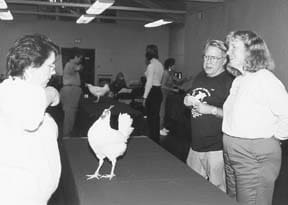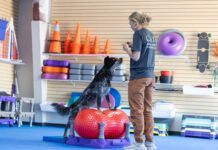Training chickens? What an odd idea! Yet all across the country, animal owners and trainers are flocking to workshops put on by a legendary husband-and-wife team, learning how to train chickens . . . so that they may better train their dogs. Here’s my account of one such workshop, held recently in Monterey, California.
In the presence of legends
It was 9 a.m., on a cool, cloudy morning in late September. Twenty-two dog trainers, hailing from all over California (and one from Illinois), were perched on the edges of our chairs, waiting with nervous anticipation for the workshop to begin. Bob and Marian Bailey, legendary animal trainers, had towed their little yellow trailer and 16 educated chickens all the way from Hot Springs, Arkansas to Monterey, California, and were now poised at the front of the room, ready to begin the two-day workshop that would unveil the finer points of clicker training to us.

Each of us, over the past several weeks and months, had survived the sheer disbelief, ridicule, giggles and guffaws of our families and dog-loving friends when we told them about the workshop.
“Why chickens?” was the universal reaction.
Training chickens, the Baileys had promised, would allow us to hone our skills on a species of animal that was especially food-focused, and that reacted with lightning speed. This would improve our timing and sharpen our powers of observation, so that we could then go home and apply our newly learned skills to training dogs – or virtually any other species of animal. We could learn from our mistakes with the Baileys’ chickens without jeopardizing our own dogs’ training programs.
I had offered to host the Chicken Clickin’ workshop back in April when the Baileys announced their West Coast tour on the Internet. When they later announced in August that they were retiring their road show in 1999 and this summer tour would be their last appearance in the West, I was triply grateful to be offering and experiencing the opportunity to see and learn clicker training from the Baileys in person.
A positive click
Clicker training is an informal term used by many trainers to mean “applied operant conditioning,” that is, training with positive reinforcement. (For more information about the variety of training philosophies utilized by trainers, see “There’s More Than One Way,” WDJ July 1998.)
The clicker trainer uses treats to reward the animal for a desired behavior. The Click! sound serves as a marker signal, or bridge, that gives the animal instant feedback about what behavior is desired. The animal quickly learns to figure out what behavior produced the treat, and to reproduce that behavior for additional treats. This method of training is easy for the average dog owner to use, because it does not require a lot of practice and skill; it only requires an open mind.
Marian and her first husband, Keller Breland, were the first trainers to use operant conditioning for practical applications, back in the 1940s. The couple founded Animal Behavior Enterprises (ABE) in 1943, and proved that the then-new scientific principles of operant conditioning developed by B.F. Skinner could be used to train virtually any kind of animal, exclusively by reward, without punishment. They worked with Skinner training pigeons to guide missiles during World War II, and created training programs and manuals for dolphin trainers, teaching the methods that are still in use today at places like Marine World and Sea World.
It was during this phase the couple began working with Bob Bailey, who, in 1964, was the first person to make a successful release and recovery at sea of a trained dolphin. Following Breland’s death in 1965, Marie and Bob continued to work together, and eventually married. All told, over the past 55 years, the three trainers have trained more than 140 different species of animals using Skinner’s principles of operant conditioning, and the techniques that they developed and applied over the years.
After Karen Pryor introduced clicker training to the dog training world in 1984 through her exceptional book, Don’t Shoot The Dog, the demand by dog trainers and owners for the Bailey’s knowledge increased exponentially. Their two-day chicken workshops grew in popularity, as did their five-day Chicken Camps, held at their expansive training facility in Hot Springs.
When word spread that the Baileys were retiring from the road, dog owners and trainers rushed to fill the limited openings in my workshop. I had elected to observe the workshop rather than be an active participant. I felt I could better apply the workshop experience to my profession of training people to train their dogs if I could watch the reactions of humans as well as the chickens.
Now, participants and observers alike waited with a sense of awe and historical appreciation for the Baileys to begin. We were in the presence of living legends.
Prerequisites of good trainers
Bob immediately put us at ease with his comfortable manner, easy charm, and sense of humor. He opened with a discussion of what it takes to be a good trainer – quick reflexes, strong powers of observation, and an understanding of the species you are working with, as well as the eccentricities of the individual animal.
Bailey got down to the nuts and bolts of chicken wrangling with the first hands-on exercise, designed to teach participants the finer points of chickenship: how to pick one up (quickly), hold it (wings pinned to prevent flapping), and carry it around (tucked under the arm). We were already learning to understand the species, as well as the eccentricities of the individual chickens we had been assigned.
The first several exercises involved learning the mechanics of delivering the Click! and food reward to the chicken in a precise and timely manner when they demonstrated the behavior we wanted. In the first exercise, the goal was to reward the chicken for pecking a target, to begin with, a large black circle.
“One peck only!” Bob reminded us again and again. “Get the food there faster! Avoid falling into a rhythm or the chicken will learn the rhythm rather than the behavior! Don’t let your body language telegraph your intentions to your chicken!”
The students practiced the mechanics of Click! and reward with varying degrees of coordination and success. Some were adept and followed Bob’s instructions to the letter. Some immediately fell into a rhythmic pattern of reward delivery despite Bob’s and their partner’s reminders.
I recognized that dog owners face similar challenges when marking and rewarding their dogs in a training class. I made a mental note to add a mechanics exercise to my first class, rather than assuming that owners know how to time the Click! and reward their dogs properly just by watching me do it.
If something goes wrong, grab your chicken!
Some participants were quite comfortable handling their chickens, while others were decidedly intimidated. Bob’s suggestion that the more confidently you handled your bird, the less likely you were to get pecked, seemed to do little to ease fears. Only the constant repetition of chicken-handling exercises convinced the less-confident handlers that they could safely handle the birds. Bob also talked about what to do if your chicken got loose on the floor. (“Don’t everybody chase it! Offer the food cup.”) And if you spilled your food cup on the table in front of your bird?
“If something goes wrong,” Bob advised, “grab your chicken.”
These observations also had applications to dog training, where there are also wide variations in confidence levels with dog owners in training classes. Perhaps if I incorporated similar handling exercises the first week of class I could increase some owners’ levels of confidence and competence with their dogs. Certainly it is true that if your dog gets loose, chasing it only encourages it to run away from you – just like the chickens. And just as the workshop chickens were attracted to the food cups, so, too, are dogs that have been trained with positive reinforcement attracted to the reward cues – the rustling of a plastic bag, or a Click! for an instant of rewardable behavior, such as a pause or a glance over the shoulder as the errant dog moves away from you.
Principles of operant conditioning
While we gave the chickens rest breaks in between exercises, Marian Bailey took center stage, teaching us proper training vocabulary and lecturing us on the principles of operant conditioning. A stimulus, she reminded us, is any change to the environment to which an animal can respond or react. Reinforcement means strengthening a response to a stimulus. Extinction is the weakening of a response to a stimulus through non-reinforcement. When we train through positive reinforcement, we reinforce behaviors by marking (clicking) the ones we want, and extinguish the behaviors we don’t want by ignoring them (non-reinforcement) rather than punishing them.
For example, a dog that tries to get attention or food by barking will quickly learn that barking is counterproductive if you turn your back when the barking starts. If you are consistent in your response, the barking will eventually extinguish. He will learn this lesson even more quickly if you Click! and reward him as soon as he is quiet, and gradually extend the length of time you expect him to stay quiet before clicking and rewarding. Most owners inadvertently do the exact opposite, by ignoring the dog when he is quiet and paying attention – “shushing” the dog – when he barks, thus teaching the dog that barking gets him the attention he craves.
Defining basic terms
We also learned the “ABCs of Behavior” – Antecedents, Behavior, and Consequences. Antecedents are events that occur before the behavior. We can increase the dog’s response to the antecedent if we make it more salient – that is, we make it stand out from the other stimuli that are present in the environment by giving it meaning. A cue, or signal, for a dog to do something is given meaning when we show him that the appropriate response to the cue will be reinforced (with a treat).
“Behavior” means anything that the dog does, such as sit, lie down, come, bark, jump up, run away, eating, breathing. A response is a particular piece of behavior we have selected to work with. Consequences are events that happen after a behavior or response takes place.
For example, if your dog sits when you say “Sit!,” you give him a piece of hot dog. The word “Sit!” is the antecedent, the dog’s sit is the behavior, or response, and the piece of hot dog is the consequence. The kind of training you have employed is called operant conditioning because the dog’s response (sit) operates on the environment – that is, it has an effect on and at least to some degree controls the consequence.
Talented chickens
Over the course of the two days we taught the chickens increasingly complex behaviors. While at first we rewarded them for a pecking at a large target, we progressed to a small black circle, and then to a tiny red dot from a laser beam. We discovered that a chicken can be taught to distinguish between several different-colored but similarly shaped pieces of paper and to peck the correct one. (This is called discrimination. An example of its use in dog training is the scent discrimination exercise in Utility obedience classes where a dog must select the article with his owner’s scent on it from among a number of other times that are identical in appearance.)
We also taught our birds to pick up and stretch a rubber band (we held one end, they pulled on the other), and then did “chaining,” which means teaching the animal to perform a series of behaviors. We taught our chickens a simple two-behavior chain – to stretch the rubber band and then peck a target before getting the Click! and reward.
While we trained the chickens, we were learning important concepts for dog training. The timing of the reinforcement is critical. You must know and visualize exactly what kinds of behaviors you will Click! and reward, or you will be late. When your reinforcement is late, you are actually rewarding the wrong behavior.
For instance, if you are trying to teach your Chihuahua to retrieve, you might begin by clicking and rewarding him for touching his nose to a ball. You must Click! the instant his nose touches the ball, and follow the click with a treat. If you are late with the Click! you will be reinforcing him for moving away from the ball rather than for touching it. While an occasional late Click! is not critical, routinely clicking too late can prevent Sam from learning to fetch the ball.
It is also important, we learned, to break down a complex behavior into tiny increments, making sure the animal thoroughly grasps each step before proceeding to the next. According to the Baileys, the biggest mistake most trainers make is trying to go too fast.
For example, when your dog suddenly seems to lose the concept of the behavior you are trying to train, it is a sign that you may have taken too big a step forward. Step back to the last place the dog was doing well, reinforce the behavior there, and figure out how to break the next step down into smaller increments.
Making slow, steady progress
To carry forward my last example, let’s say you have succeeded in getting your Chihuahua to reliably pick up the ball on cue. In your excitement over your success, you now toss the ball across the yard and give the dog the cue to pick it up. The Chihuahua, not being a natural retriever, stands and looks at you uncomprehendingly. You have taken too big a step.
If the dog has been picking up the ball from the ground directly in front of him, go back and repeat and reinforce this response a few times. Now you might try moving the ball just a foot away and giving the cue. If that is too much, you might try six inches, or three, until he gets it, and then continue increasing the distance in small increments, until he will fetch the ball from across the yard.
In order to avoid making the mistake of going too fast, according to Bob, you should analyze the topography, or shape, of the behavior before you begin to train a new behavior. Then you should create a written training plan, and lay out the goals for each session. While you may have a goal in mind for each session, you must also be flexible and be prepared to revise the plan if it isn’t working, by re-analyzing the behavior and looking for different ways to approach the training, perhaps breaking down the steps into even smaller increments.
Reinforce, reinforce!
Another key concept presented by the Baileys was the importance of giving lots of reinforcement. Many dog owners and trainers are too stingy with the Click! and reward. If you don’t give enough reinforcement, you lose your dog’s attention. Our chickens were quick to hit the floor and look for stray bits of food if the rewards were coming too slowly up on the table. Similarly, our dogs are easily distracted in the very stimulating environment of a dog training class if we don’t give them a good reason – plenty of Clicks! and treats – to stay focused on us.
Students also tend to stop giving rewards too soon. My dogs, although they are well-trained and will respond without food rewards, still gets lots of reinforcement, including praise, petting and treats, for doing what I ask. Responding to my requests for behavior is their job, so I make sure I pay them for doing it. Most people wouldn’t continue working at their jobs with enthusiasm unless they got paid occasionally. Why should we expect our dogs to work for free?
Inspiration
As the workshop drew to a close, I listened to the excited chatter of the participants. Inspired, we discussed our plans for going home and training our human and animal students. We were armed with new approaches to resolving stubborn training challenges (visualize the topography of the behavior and break it down into smaller steps). We had new ideas for teaching new behaviors. As one person departed, she announced her intention to go home and train her pigeon, while I entertained thoughts of trying to test my training skills by teaching my desert tortoise to “run” an obstacle course.
Training chickens had improved our dog training abilities by improving our understanding of this powerful, positive method of training, sharpening our behavior-observation skills, and honing our reflexes and timing for rewards. Of course, most of us were already aware that clicker-trained dogs are now winning obedience titles, agility competitions, and joyfully dancing with their owners in musical freestyle events. Yet, training those plain white chickens to perform complex behaviors on cue reminded us of the endless possibilities of positive-reinforcement animal training.
-By Pat Miller





